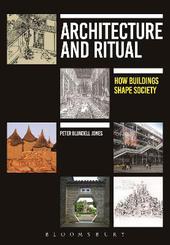
|
Architecture and Ritual: How Buildings Shape Society
Paperback / softback
Main Details
| Title |
Architecture and Ritual: How Buildings Shape Society
|
| Authors and Contributors |
By (author) Professor Peter Blundell Jones
|
| Physical Properties |
| Format:Paperback / softback | | Pages:392 | | Dimensions(mm): Height 244,Width 169 |
|
| Category/Genre | Theory of architecture
History of architecture |
|---|
| ISBN/Barcode |
9781472577481
|
| Classifications | Dewey:720.1 |
|---|
| Audience | | Professional & Vocational | |
|---|
| Illustrations |
280 bw illus
|
|
Publishing Details |
| Publisher |
Bloomsbury Publishing PLC
|
| Imprint |
Bloomsbury Academic
|
| Publication Date |
25 August 2016 |
| Publication Country |
United Kingdom
|
Description
Architecture and Ritual explores how the varied rituals of everyday life are framed and defined in space by the buildings which we inhabit. It penetrates beyond traditional assumptions about architectural style, aesthetics and utility to deal with something more implicit: how buildings shape and reflect our experience in ways of which we remain unconscious. Whether designed to house a grand ceremony or provide shelter for a daily meal, all buildings coordinate and consolidate social relations by giving orientation and focus to the spatial practices of those who use them. Peter Blundell Jones investigates these connections between the social and the spatial, providing critical insights into the capacity for architecture to structure human ritual, from the grand and formal to the mundane. This is achieved through deep readings of individual pieces of architecture, each with a detailed description of its particular social setting and use. The case studies are drawn from throughout architectural history and from around the globe, each enabling a distinct theoretical theme to emerge, and showing how social conventions vary with time and place, as well as what they have in common. Case studies range from the Nuremberg Rally to the Centre Pompidou, and from the Palace of Westminster to Dogon dwellings in Africa and a Modernist hospital. In considering how all architecture has to mesh with the habits, beliefs, rituals and expectations of the society that created it, the book presents deep implications for our understanding of architectural history and theory. It also highlights the importance for architects of understanding how buildings frame social space before they prescribe new architectural designs of their own. The book ends with a recent example of user participation, showing how contemporary user interest and commitment to a building can be as strong as ever.
Author Biography
Peter Blundell Jones was Professor of Architecture at the University of Sheffield from 1994 until his death in 2016. He previously held teaching positions at the University of Cambridge and at London South Bank University, and was a prominent architectural writer, critic and historian.
ReviewsUsing examples ranging from farmhouses to hospitals to Cedric Price's Fun Palace, Peter Blundell Jones shows how the use of buildings is intimately tied to their social meaning. This carefully researched and well-argued book thereby helps re-cast architectural theory, bringing together separate frameworks-function, aesthetics and cultural value-into a single discourse. * Professor Howard Davis, Faculty for Architecture at the University of Oregon, USA * For those working in urban studies, Architecture and Ritual provides an important perspective on how human societies at any scale (family, tribe, city, nation) form and are formed by their built environments. It would be especially helpful for anyone working to understand people's ways of life in the metropolitical context and how these ways are, to a significant degree, influenced by their architecture. * Journal of Urban Affairs * In a major contribution to the study of the anthropology of building, Peter Blundell Jones explores architecture's role as a setting for communal rituals, balancing familiar and less familiar examples from a range of cultures to provide many insights into the shared origins of different expressions in the buildings of both modern and traditional societies. * Dr Eamonn Canniffe, Principal Lecturer at the Manchester School of Architecture, UK *
|